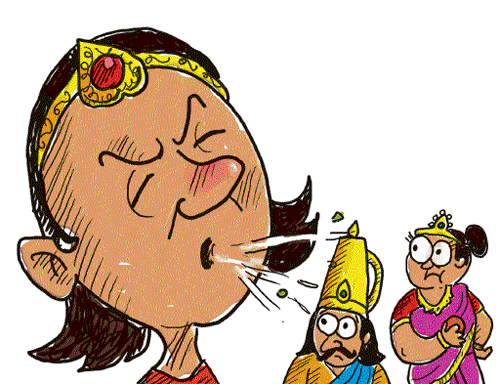What does it take to turn a drifting, lackluster mechanical engineering diploma holder into a high flying illustrator, animator, graphic designer and novelist?
It could be talent and creativity — and either courage or a certain happy-go-lucky approach to life. Certainly, Ashok Rajagopalan has all of this in plenty, besides a terrific, home-grown sense of humour. That is possibly the key to his fantastic run with art illustration. For many years now, his versatile and nimble fingers have been bringing to life an astounding range of characters from anglicised toons to lovable, son-of-the-soil characters like the adorable elephant Gajapati Kulapati, Mumbo Jumbo the Magician, Eecha Poocha, Thangi, Mor Khan, Kurumolagu and Amminikutty.
“Unless I sign my name, nobody would recognise my illustrations or caricatures to be mine. I suppose I don’t have a style, unlike masters like Mario Miranda and others,” he says in his trademark self-effacing manner. But this versatility actually translates to a strength, because it allows him to illustrate every kind of storyline, and keep generations of kids (and adults) happy with characterisations that are both richly conceived and far removed from each other.
“When I began, I didn’t know art could make for a living. I learnt to dabble in art like all kids,” Ashok points out and adds impishly, “But I had great gurus to guide me — Michelangelo, Leonardo, Van Gogh, Monet, Turner, Uderzo, Mario Miranda… and many others. Luckily, drawing lessons come free of cost when you are ready to copy and learn.” Well, that is how Ashok learned art, though he did veer off into mechanical engineering, and then drifted into marketing with a DTP studio, until a tiff with his boss gave him the impulse to resign and turn to art.
“I told my then boss Kothandaraman that while I liked the company, I didn’t like the marketing job. I said I would resign, qualify myself as an artist and join the company again. But my boss just opened the door to the design centre and asked me to get going,” Ashok shares with a grin. Well, those were the days.
Ashok gravitated — or rather, levitated naturally to illustrating for children, finding it more fun, lively and holding more scope for imagination. His first break with big-time illustrating came with Chandamama’s Junior Quest in 1989, which eventually folded up, like many other children’s magazines. “It is a pity that lack of revenue inevitably hits children’s magazines in a matter of a few years and they fold up. I can only say that I have been lucky in surviving this turn of events,” he says.
Since that dubious start, Ashok has been busy illustrating countless stories and characters for classy publishing houses like Tulika, Macmillan, Oxford, Orient Longman, Chandamama’s Junior Quest, and University Press, children’s magazines — Impulse Hoot and Toot, storyboards for the comic Dynast (to be published this year), besides cartoons for video films. He has produced a massive volume of work over the last 24 years. “I am not much of a hard worker, but assignments keep coming in and then, there is the housing loan to repay now,” he puts in, explaining away the prodigious output.
In part, Ashok’s illustrations achieve their eclectic appeal because he is unafraid of dabbling with a variety of media. From pastels and negative imaging techniques favoured by fine artists to illustrating with spray paint used in automobile painting, he has tried all kinds of media. That is why some of his illustrations become works of art by themselves.
Lately, he does all his art work on the computer, having decided to go green. “I decide on the style and the medium based on the story or the text,” he says.
Ashok is also one of those malleable characters who turn illustrator, graphic designer, animator and even ‘writer’ on impulse. In between drawing, Ashok has been writing books in offbeat genres like Witchsnare, a game book that lets you chose your own endings from a dozen possibilities, and Ajit the Archer, a novel for children. Unfortunately, Witchsnare didn’t do as well as it deserved, perhaps because Indian readers are not familiar with the gamebook concept. “I should bring it in online version, I think. The links and hyperlinks in a cyber book would be more attractive than an oxymoronic phrase like, ‘Turn to page 44 if you are feeling adventurous and want to jump into the action’,” he says, revealing a savvy understanding of psychology.
Ashok has also penned abridged versions of The Iliad and The Odyssey. But even more famous is his online series called Lemon, Salt, Soda, that obviously hero-worships P G Wodehouse. Ashok’s blogs, under the pseudonym Kenny Wordsmith, have been well-received too. “Someday, I want to be known as a writer,” he says. P G Wodehouse and Isaac Asimov are his favourite writers. When it comes to illustrations, he is a fan of Marvel comics, DC and Peanuts.
Working from home, Ashok says he works in bits and pieces, and even manages to find time to watch TV soaps in between. He finishes, “I don’t lay claim to any great talent. As kids, we had that indescribable happiness in drawing and creating things, and the happiness showed in our drawings and creations. As we grow older, we lose that happiness in the act of creating and think more of what it would bring us, how it would be received, etc. I am still happy when I draw. I think that greatly contributes to my success in illustrating for children.”
